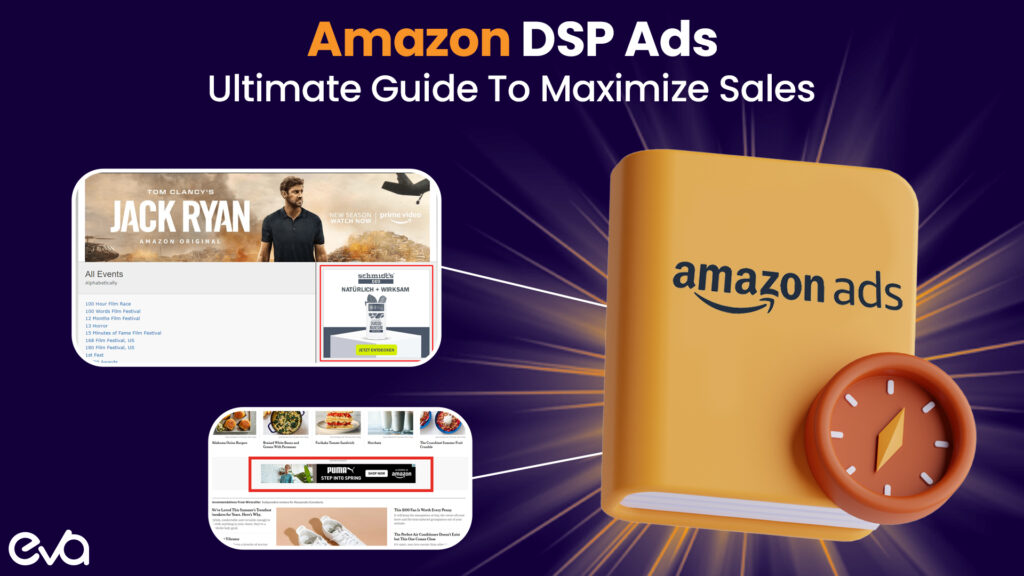Are you an eCommerce seller wondering what is Amazon DSP advertising and how it can transform your business? Or, maybe you’re curious why every Amazon conference has standing-room-only seminars on Amazon DSP?
The competition for customer attention on Amazon has never been more intense, and Amazon’s next-level Demand-Side-Platform (DSP) is nothing short of revolutionary!
That’s because Amazon DSP, their programmatic advertising platform allows you to reach potential customers both on and off Amazon’s platform!
The time has come to leverage strategic Amazon DSP campaigns that target high-intent shoppers wherever they browse online.
By understanding the right Amazon DSP bidding strategy, you can optimize your ad spend while dramatically expanding your reach beyond the marketplace itself.
Table of Contents
- What are Amazon DSP Ads?
- Tips For Amazon DSP Ads Setup
- How To Set Up Your First Amazon DSP Ad Campaign
- Best Practices for Amazon DSP Ads Targeting
- Optimizing Amazon DSP Ads Performance
- Amazon DSP Ads Campaign Management
- Measuring Success With Amazon DSP Ads
- Attribution Modeling
- Amazon DSP Ads Budgeting Tips
- Difference Between Amazon DSP Ads & Sponsored Ads
- Integrating Amazon DSP Ads with Other Marketing Channels
- Benefits of Using Amazon DSP Ads for Brand Awareness
- Building Brand Authority & Trust
- Amazon DSP Ads To Increase Conversions
- Remarketing with Amazon DSP Ads
- Amazon DSP Ads for Product Launches
- Amazon DSP Ads vs. Traditional Display Advertising
- Expanding Reach with Amazon DSP Ads
- Tracking & Analyzing Amazon DSP Ads Data
- Amazon DSP Ads For Seasonal Campaigns
- Conclusion
- FAQs
What are Amazon DSP Ads?
Amazon DSP ads (Demand Side Platform) represent a sophisticated programmatic advertising solution that enables precise audience targeting across Amazon’s vast network and beyond.
This powerful platform allows advertisers to deliver personalized messaging to relevant shoppers based on their browsing behavior, purchase history, and demographic information.
Unlike standard sponsored product placements, Amazon DSP ads examples include engaging display ads, video content, and audio advertisements that can appear on Amazon-owned sites, third-party websites, and apps within Amazon’s extensive publisher network.
The platform’s strength lies in its comprehensive DSP campaign monitoring with AMC (Amazon Marketing Cloud), providing invaluable insights for continuous optimization and maximum return on ad spend.
Let’s check it out:
| Amazon DSP | Amazon PPC | Google Display Ads | |
| Targeting | Utilizes Amazon’s rich shopper data to offer advanced audience targeting and segmentation | Targets keywords, product categories, and specific ASINs within Amazon’s search results | Provides extensive audience targeting options based on user data and interests, both on Google-owned sites and partner sites |
| Ad Inventory | Offers access to premium ad inventory across Amazon-owned sites and apps, as well as | Primarily displays sponsored products or sponsored brands within Amazon’s search results | Provides a vast network of websites and apps to display ads in various formats and placements |
| Ad Formats | Provides a range of ad formats including display, video, audio, and OTT (over-the-top) | Provides a range of ad formats, including display, video, audio, and OTT (over-the-top) | Supports various ad formats, including banners, videos, native, interactive, and responsive ads |
| Campaign Control | Enables programmatic buying with real-time optimization and data-driven decision-making | Allows manual keyword bidding, budget control, and ad placement adjustments | Offers control over targeting, bidding strategies, ad placements, and budget allocation |
| Reach | Reaches audiences both on and off Amazon | Primarily reaches shoppers on Amazon | Extensive reach across the Google Display Network |
| Performance | Provides detailed performance metrics and reporting for campaign optimization | Offers performance metrics and reporting within Amazon Advertising Console | Offers robust reporting and optimization tools |
| Cost Structure | Works on a cost-per-thousand-impressions (CPM) or cost-per-click (CPC) basis | Operates on a cost-per-click model | Utilizes various pricing models like CPM or CPC |
| eCommerce Focus | Focused on driving sales on the Amazon platform | Focused on driving sales on Amazon platform | Suitable for broader brand awareness and lead generation |
| Ad Network | Offers reach beyond Amazon through partnerships with external websites and apps | Primarily targets ads within Amazon’s ecosystem | Extensive reach across the Google Display Network |
Tips For Amazon DSP Ads Setup
Campaign Structure & Targeting Options

Creating a well structured campaign is essential for success. Begin by defining your campaign objectives, selecting appropriate targeting options, and determining the budget allocation for each campaign.
Pro Tip: Align your campaign objectives with your overall business goals. For example, if your goal is to drive conversions, focus on targeting audiences that are likely to make a purchase rather than just optimizing for impressions.
Example: Suppose you’re a fashion brand looking to promote your new line of summer dresses. Instead of targeting a broad audience, narrow your targeting options to reach fashion enthusiasts, women within a specific age range, and those interested in similar products.
This targeted approach increases the likelihood of reaching potential customers who are more likely to convert.
Ad Creative Creation and Optimization

The creative elements of your Amazon DSP Ads play a crucial role in capturing the attention of your audience and driving engagement.
Design visually compelling creatives that align with your brand identity and resonate with your target audience.
Pro Tip: Conduct A/B testing to identify the most effective ad creatives. Test different images, headlines, and calls to action to optimize performance and achieve better results.
Example: Let’s say you’re running a campaign to promote your new line of organic skincare products. Test two different ad creatives—one featuring a product close up and another showing a model using the product.
Monitor the performance of each creative and allocate more budget to the one that generates higher click-through rates and conversions.
Tracking and Measurement Setup
To accurately measure your Amazon DSP Ads campaigns’ success, it’s essential to set up tracking and measurement mechanisms.
Utilize Amazon’s reporting tools and third party analytics platforms like Eva to gain in depth insights into campaign performance.
Pro Tip: Implement conversion tracking pixels and UTMs to attribute conversions accurately. Leverage comprehensive analytics tools like Eva to access advanced reporting and optimize your campaigns based on meaningful data.
Advertiser Qualifications & Requirements
Understanding the qualifications and requirements for running Amazon DSP Ads is important. Amazon sets specific criteria for advertisers, such as minimum spend thresholds or working with approved Amazon DSP partners like Eva.
Pro Tip: Ensure you meet the qualifications and requirements by reviewing Amazon’s guidelines for running DSP Ads. Consider partnering with an experienced DSP provider like Eva to streamline the setup process and maximize your results if needed.
How To Set Up Your First Amazon DSP Ad Campaign
Step 1: Define Your Campaign Objectives
To set up a successful Amazon DSP Ad campaign, clearly define your campaign objectives.
For example, if your goal is to increase brand awareness, consider running display banner ads highlighting your brand’s unique value proposition. If you aim to drive website traffic, focus on compelling video ads that captivate viewers and direct them to your website.
Pro Tip: Align your campaign objectives with your overall marketing goals and ensure they are specific, measurable, attainable, relevant, and time bound (SMART). This will help you stay focused and track your progress effectively.
Step 2: Identify Your Target Audience
One of the key advantages of Amazon DSP Ads is the ability to target specific audiences. Leverage Amazon’s vast customer data to identify your target audience based on demographics, interests, and behaviors.
For example, if you sell fitness apparel, you can target health conscious individuals who frequently purchase fitness related products.
Pro Tip: Conduct thorough research to understand your target audience’s preferences, pain points, and shopping behavior. This will enable you to craft more personalized and impactful ad campaigns that resonate with your audience.
Step 3: Select Ad Formats



Amazon DSP Ads offer various ad formats, depending on your campaign goals and target audience. Display banners, video ads, and carousel ads are popular options for creative storytelling and capturing attention.
Pro Tip: Experiment with different ad formats to understand which ones perform best for your specific objectives and target audience. Test different creatives within each format to find the winning combination that drives the highest engagement and conversions.
Step 4: Set Your Budget
Before launching your campaign, determine a budget that aligns with your goals and resources. Start with a realistic budget and allocate funds based on your objectives, target audience size, and anticipated ROI.
Pro Tip: Monitor your campaign performance closely and adjust your budget accordingly. Allocate more budget to top performing ads or target audiences to maximize your return on investment.
Step 5: Create Compelling Ad Creatives

Craft visually appealing and compelling ad creatives that grab attention and communicate your brand’s value proposition effectively. Use high quality images or videos, persuasive copy, and clear calls to action.
Pro Tip: Conduct A/B testing with different creatives to identify the most engaging and persuasive elements. Continuously iterate and optimize your creatives based on data driven insights to improve your campaign’s performance.
Step 6: Define Targeting Parameters
Take advantage of Amazon DSP’s advanced targeting capabilities to refine your audience targeting. Set parameters based on demographics, interests, behaviors, and even specific products or categories to reach your ideal customers.
Pro Tip: Leverage customer data to create custom audience segments and lookalike audiences. This allows you to expand your reach to users who exhibit similar characteristics and behaviors to your existing customers, increasing the chances of conversions.
Step 7: Set Bids & Optimization Strategy
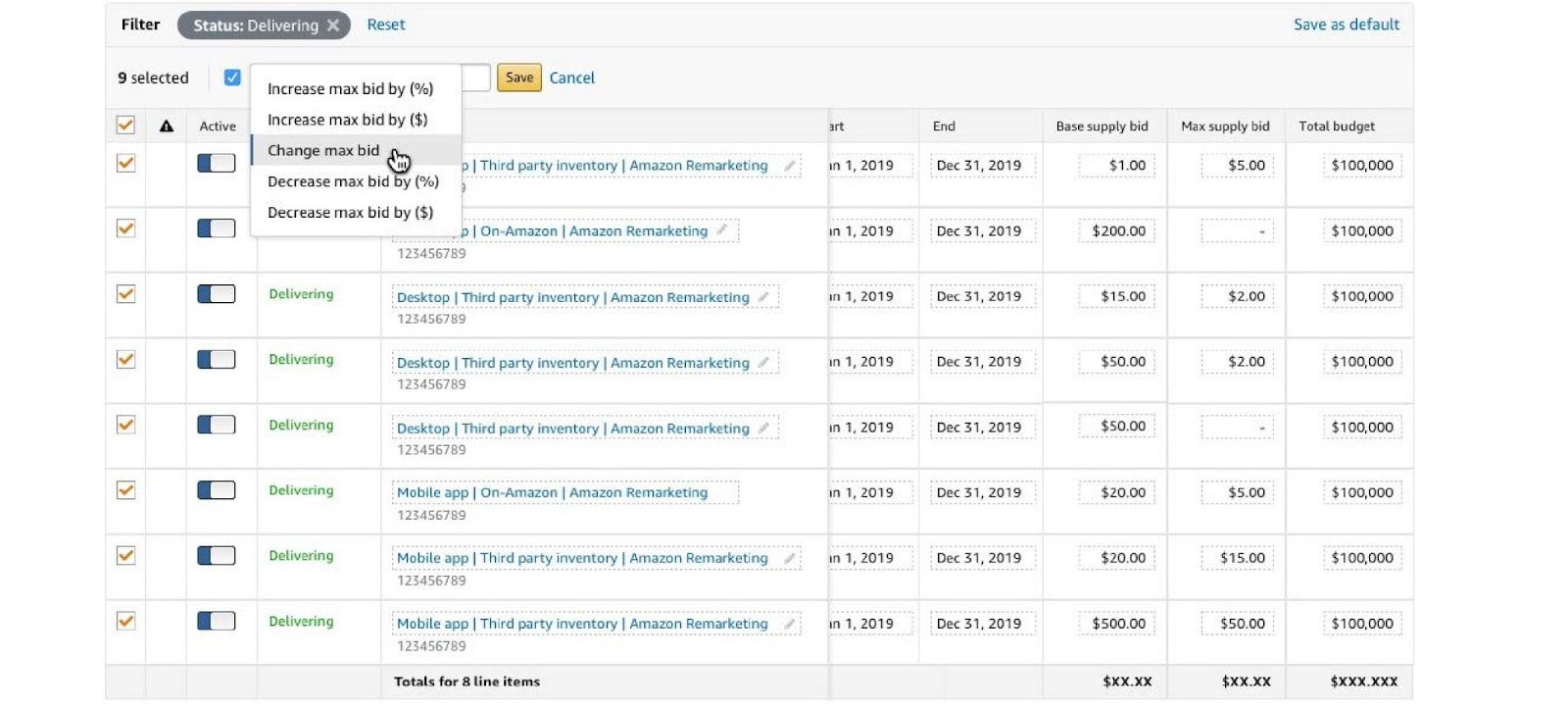
Bid setting for DSP ads
Determine your bidding strategy to compete effectively for ad placements. Consider factors such as your campaign objectives, target audience, and desired ROI.
Regularly monitor your campaign performance and adjust bids to ensure optimal visibility and cost efficiency.
Pro Tip: Utilize Amazon DSP’s optimization features, such as automatic bidding or dynamic bidding, to maximize the performance of your ads. Test different bidding strategies and monitor the impact on key metrics to find the most effective approach.
Step 8: Launch & Monitor Your Campaign
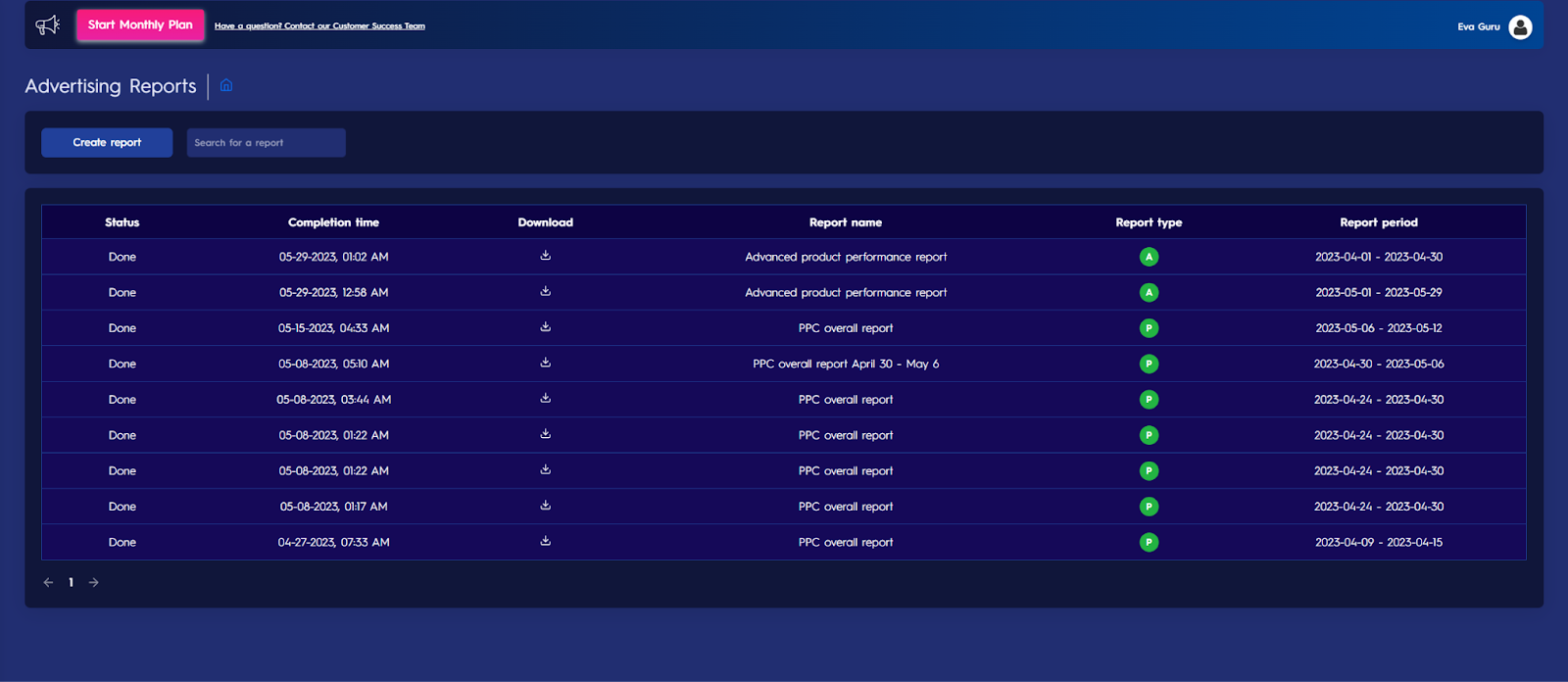
Once your campaign is set up, launch it and closely monitor its performance using Amazon’s reporting and analytics tools. Keep a close eye on key metrics such as impressions, clicks, conversions, and return on ad spend (ROAS).
Pro Tip: Set up automated reports and alerts to receive regular updates on your campaign’s performance. This allows you to identify any issues or opportunities promptly and take necessary actions to optimize results.
Step 9: Continuously Optimize & Refine
Optimization is an ongoing process in Amazon DSP Ad campaigns. Regularly analyze campaign data, identify areas for improvement, and make data-driven decisions to optimize your campaign.
Pro Tip: Conduct regular A/B tests on different elements such as ad creatives, targeting parameters, bidding strategies, and landing pages. Use the insights gained to refine your campaign and drive better results over time.
By following these actionable steps and leveraging the advanced features of Amazon DSP Ads, you can set up a robust and effective advertising campaign that drives meaningful results for your business.
Now, go ahead and take action to unlock the full potential of Amazon DSP Ads and drive growth for your brand!
Best Practices for Amazon DSP Ads Targeting
Leveraging First-Party Data for Precise Targeting
Utilize first party data, such as customer search and purchase behavior, to create highly targeted campaigns.
Leverage this valuable data to refine your targeting strategies and deliver personalized ad experiences to the right audience segments.
Pro Tip: Analyze your customer data to identify patterns, preferences, and purchase history. Utilize this information to create custom audience segments and deliver highly relevant ads to each group.
Lookalike Audience Targeting
Lookalike audience targeting allows you to expand your reach by targeting users who share similar characteristics with your existing customer base.
This targeting strategy helps you discover new potential customers likely to be interested in your products or services.
Pro Tip: Identify your top performing customer segments and create lookalike audiences based on their attributes.
This method enables you to reach a broader yet relevant audience and increase the chances of acquiring new customers.
Example: Let’s say you have a segment of customers who consistently purchase high end beauty products.
Creating a lookalike audience based on this segment can extend your reach to potential customers with similar preferences for luxury beauty items.
Optimizing Amazon DSP Ads Performance
Continuous Monitoring and Optimization
Regularly monitor your Amazon DSP Ads campaigns to identify areas for improvement and optimize performance.
Keep a close eye on key metrics such as impressions, click through rates, conversions, and return on ad spend (ROAS).
Pro Tip: Set up regular check ins and analyze campaign performance to identify underperforming areas. Adjust targeting, creative elements, and bids accordingly to optimize results.
Dynamic Creative Optimization
Dynamic Creative Optimization (DCO) allows you to personalize ad creatives in real time based on audience attributes, such as location, demographics, or browsing behavior.
By tailoring creatives to each viewer, you can enhance engagement and drive higher conversion rates.
Pro Tip: Implement DCO strategies to deliver personalized ad experiences to your audience. Leverage dynamic product feeds and creative templates to automate the customization process and improve performance.
Amazon DSP Ads Campaign Management
![Blog2 [kurtarılan] 08](https://eva.guru/wp-content/uploads/2023/06/blog2-kurtarilan-08.jpeg)
Daily Monitoring and Budget Allocation
Monitor your campaigns daily to ensure they are running smoothly and achieving the desired results.
Adjust your budget allocation based on the performance of each campaign to maximize the return on your advertising investment.
Pro Tip: Keep a close eye on key performance metrics and make necessary adjustments to your budget allocation. Increase the budget for high performing campaigns and reallocate funds from underperforming ones.
Experimentation & Iteration
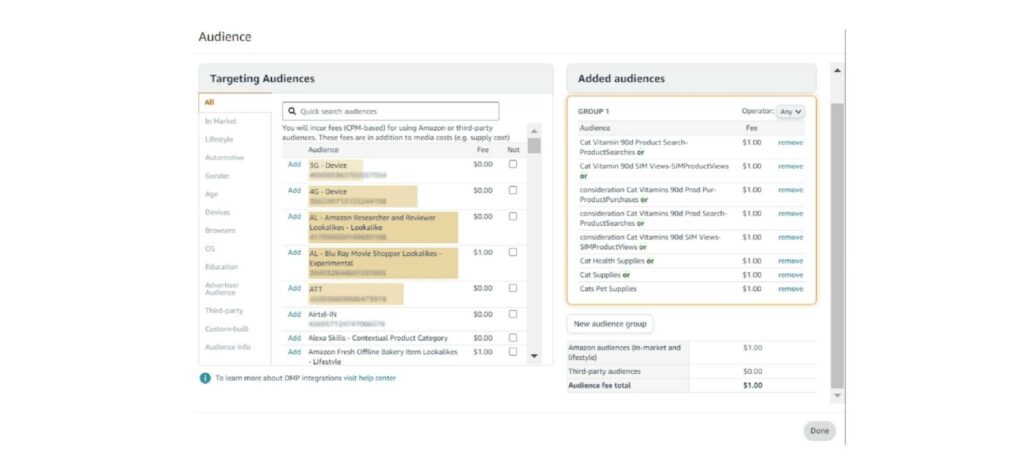
Continuously test and experiment with different targeting options, ad formats, and strategies to find what works best for your brand. Embrace a culture of iteration and improvement to stay ahead of the competition.
Pro Tip: Conduct A/B tests, try new targeting options, and experiment with different ad formats to discover what resonates most with your target audience. Analyze the results and iterate based on data driven insights.
Measuring Success With Amazon DSP Ads
Key Performance Indicators (KPIs) for Amazon DSP Ads
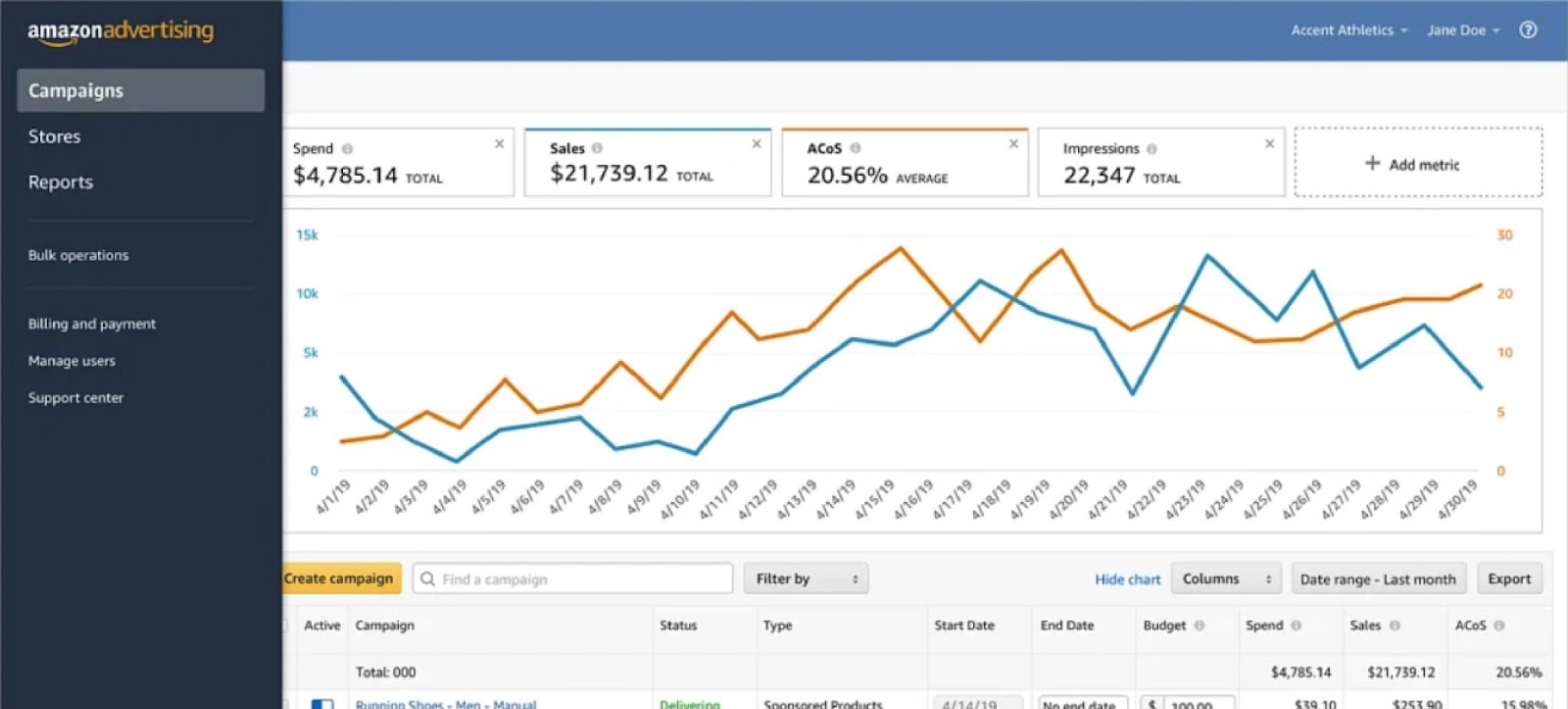
Defining and tracking relevant KPIs is crucial to evaluate the success of your Amazon DSP Ads campaigns.
Key metrics to consider include impressions, click through rates (CTR), conversion rates, ROAS, and return on investment (ROI).
Pro Tip: Determine the KPIs that align with your campaign objectives and monitor them consistently. Regularly analyze and compare these metrics to understand campaign performance and make data driven decisions.
Attribution Modeling
Proper attribution modeling allows you to understand the impact of your Amazon DSP Ads across the customer journey.
It helps you allocate credit to each touchpoint and optimize your marketing efforts accordingly.
Pro Tip: Implement an attribution model that aligns with your business goals and provides a holistic view of your campaign’s performance.
Consider multi touch attribution models considering various touchpoints along the customer journey to gain deeper insights.
Amazon DSP Ads Budgeting Tips
Establishing a Realistic Budget
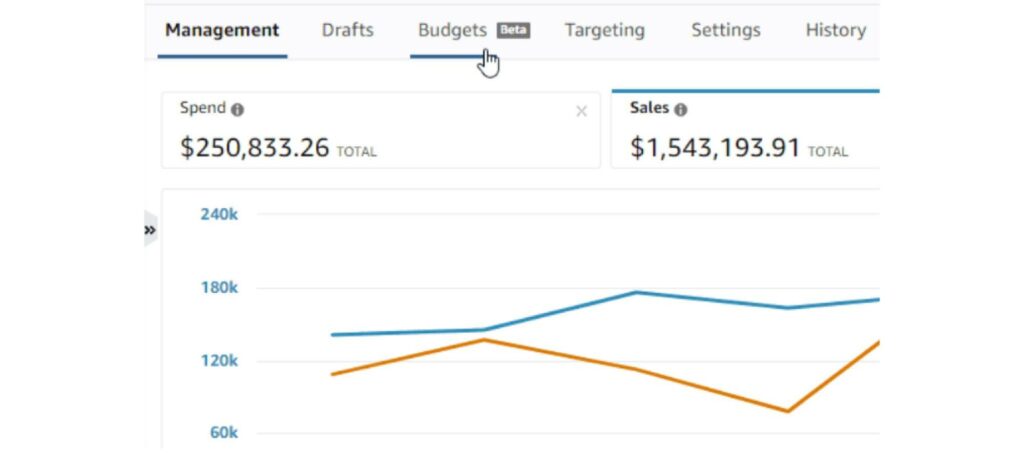
Setting a realistic budget is crucial for the success of your Amazon DSP Ads campaigns. Take into account your campaign objectives, target audience size, and competition within your industry when determining your budget.
Pro Tip: Evaluate your business goals and calculate the potential return on investment (ROI) to determine an appropriate budget for your Amazon DSP Ads campaigns.
Allocate funds strategically to maximize your reach and results.
Dynamic Budget Allocation
Consider implementing dynamic budget allocation strategies to optimize your ad spend.
You can maximize your advertising ROI by allocating more budget to high performing campaigns and reducing spending on underperforming ones.
Pro Tip: Continuously monitor campaign performance and adjust your budget allocation accordingly.
Focus your budget on campaigns that generate the best results and reallocate funds from less effective campaigns.
Difference Between Amazon DSP Ads & Sponsored Ads
Understanding the Distinctions
While both Amazon DSP Ads and Sponsored Ads serve as advertising solutions on Amazon, they differ in terms of targeting capabilities, ad placements, and audience reach.
Understanding these distinctions can help you make informed decisions about which advertising option to leverage for your specific goals.
Pro Tip: Familiarize yourself with the differences between Amazon DSP Ads and Sponsored Ads to determine which platform aligns best with your campaign objectives and target audience.
Integrating Amazon DSP Ads with Other Marketing Channels
Synergistic Integration with Sponsored Ads & SEO
Integrating Amazon DSP Ads with other marketing channels, such as Sponsored Ads and SEO, can amplify your overall marketing efforts. By leveraging the strengths of each channel, you can create a cohesive and comprehensive marketing strategy.
Pro Tip: Develop an integrated marketing approach by aligning your Amazon DSP Ads with your Sponsored Ads and SEO strategies.
Utilize cross channel insights to optimize your campaigns and enhance overall performance.
Benefits of Using Amazon DSP Ads for Brand Awareness
Reaching a Wider Audience
Amazon DSP Ads enable you to extend your reach beyond the traditional Amazon customer base.
By targeting users across various websites, apps, and devices, you can expand your brand’s visibility and increase awareness among new audiences.
Pro Tip: Consider using Amazon DSP Ads as part of your brand awareness campaigns to reach a broader audience. Develop compelling ad creatives and leverage targeting options to increase brand recognition and exposure.
Building Brand Authority & Trust
Consistently appearing in front of your target audience through Amazon DSP Ads helps establish your brand as an authority in your industry.
You can build trust and credibility among potential customers by delivering relevant and engaging ads.
Pro Tip: Craft ad creatives that highlight your brand’s unique selling points, value propositions, and customer testimonials.
Use compelling visuals and persuasive messaging to position your brand as a trusted authority in the market.
Amazon DSP Ads To Increase Conversions
Dynamic Product Remarketing
Dynamic product remarketing with Amazon DSP Ads allows you to retarget users who have previously shown interest in specific products.
By showcasing personalized ads featuring the users of the exact products viewed, you can engage with them and drive conversions.
Pro Tip: Implement dynamic product remarketing campaigns to recapture the attention of users who have shown intent but haven’t converted.
Use compelling ad creatives and promotional offers to entice them to complete their purchase.
Incorporating Uplift Modeling & Predictive Analytics
Leverage uplift modeling and predictive analytics to identify the most responsive audience segments and optimize your Amazon DSP Ads campaigns for maximum conversions.
These advanced techniques enable you to focus your resources on users who are most likely to convert.
Pro Tip: Leverage data driven insights and predictive analytics tools to identify the most responsive audience segments.
Allocate your budget and bidding strategies accordingly to increase conversion rates and maximize ROI.
Remarketing with Amazon DSP Ads
Tailoring Ads for Remarketing Campaigns
Remarketing campaigns allow you to reconnect with users who have previously interacted with your brand.
Tailor your Amazon DSP Ads specifically for these campaigns to remind users of your offerings and encourage them to take the next step.
Pro Tip: Customize your ad creatives and messaging to align with the user’s previous interaction with your brand. Highlight special offers, incentives, or additional information to engage users and drive conversions.
Utilizing Sequential Messaging

Deliver sequential messaging through Amazon DSP Ads to guide users through the customer journey.
By presenting users with a series of ads that build upon each other, you can create a cohesive and persuasive narrative that leads to conversions.
Pro Tip: Develop a sequential messaging strategy that strategically delivers ads at different stages of the customer journey.
Begin with awareness focused ads, then transition to consideration and conversion focused ads to drive action.
Amazon DSP Ads for Product Launches

Generating Buzz & Anticipation
Use Amazon DSP Ads to create excitement and anticipation for your product launches. Build pre launch buzz by delivering targeted ads to potential customers, teasing product features, and highlighting exclusive launch promotions.
Pro Tip: Plan and execute Amazon DSP Ads campaigns that align with your product launch timeline.
Create a sense of urgency, emphasize unique selling propositions, and leverage influencer partnerships to generate buzz and drive early adoption.
Leveraging Retargeting for Post-Launch Success
After your product launch, continue to leverage Amazon DSP Ads for post launch success.
Utilize retargeting strategies to engage users who showed interest in your launch but did not convert and encourage them to make a purchase.
Pro Tip: Set up retargeting campaigns to reach users who interacted with your product launch ads but did not convert.
Tailor your messaging to highlight the product’s value, benefits, and any limited time offers or discounts to drive conversions.
Amazon DSP Ads vs. Traditional Display Advertising
| Amazon DSP Ads | Traditional Display Advertising | |
| Targeting | Provides advanced targeting options based on Amazon’s rich shopper data, allowing advertisers to reach specific audiences with precision. | Relies on demographic and contextual targeting, which may be less precise and focused compared to Amazon’s shopper data. |
| Ad Placement | Extensive reach across Amazon-owned sites and apps, as well as partner sites and apps, enabling ads to be displayed in various relevant locations. | Primarily focuses on placements on third-party websites and apps, with limited control over where ads are displayed. |
| Ad Formats | Offers a variety of ad formats, including display, video, and audio ads, tailored for different placements and devices. | Primarily utilizes standard display ad formats, with limited options for video and audio ads. |
| Ad Performance | Provides access to detailed performance metrics and insights, allowing advertisers to optimize campaigns and measure return on investment (ROI) effectively. | Provides advanced targeting options based on Amazon’s rich shopper data, allowing advertisers to precisely reach specific audiences. |
| Ad Costs | Works on a cost-per-thousand-impressions (CPM) or cost-per-click (CPC) basis, providing flexibility in budget allocation and optimization. | Offers basic performance metrics but may not provide the same level of detailed insights and attribution tracking as Amazon DSP. |
| Target Audience | Ideal for sellers and brands looking to increase product visibility, drive sales on Amazon, and leverage the platform’s vast customer base. | Suitable for businesses aiming to reach a broader audience beyond Amazon, focusing on brand awareness, lead generation, or website traffic. |
Targeted Audience Reach
Amazon DSP Ads provide highly targeted audience reach, allowing you to deliver ads to users who are actively shopping on Amazon or have demonstrated relevant interests.
This level of precision targeting sets Amazon DSP Ads apart from traditional display advertising.
Pro Tip: Consider the specific targeting options and audience reach provided by Amazon DSP Ads when deciding between Amazon DSP Ads and traditional display advertising.
Evaluate which platform aligns better with your target audience and campaign objectives.
Expanding Reach with Amazon DSP Ads
Cross-Channel Expansion
Amazon DSP Ads allow you to expand your reach beyond the Amazon platform by targeting users across various websites, apps, and devices.
This crosschannel expansion increases the visibility of your brand and products, enabling you to reach potential customers wherever they are.
Pro Tip: Develop cross channel strategies that leverage Amazon DSP Ads to expand your reach and target audiences outside of the Amazon ecosystem.
Consider partnering with premium publishers and utilizing programmatic advertising to amplify your brand exposure.
Tracking & Analyzing Amazon DSP Ads Data
Comprehensive Data Analysis

Leverage the data provided by Amazon DSP Ads to gain valuable insights into your campaign performance.
Analyze key metrics, such as impressions, click through rates, conversions, and cost per acquisition, to measure the success of your campaigns.
Pro Tip: Utilize advanced analytics platforms like Eva to gain deeper insights into your Amazon DSP Ads data. Leverage data visualization, trend analysis, and segmentation to identify patterns and optimize your campaigns for better results.
Amazon DSP Ads For Seasonal Campaigns
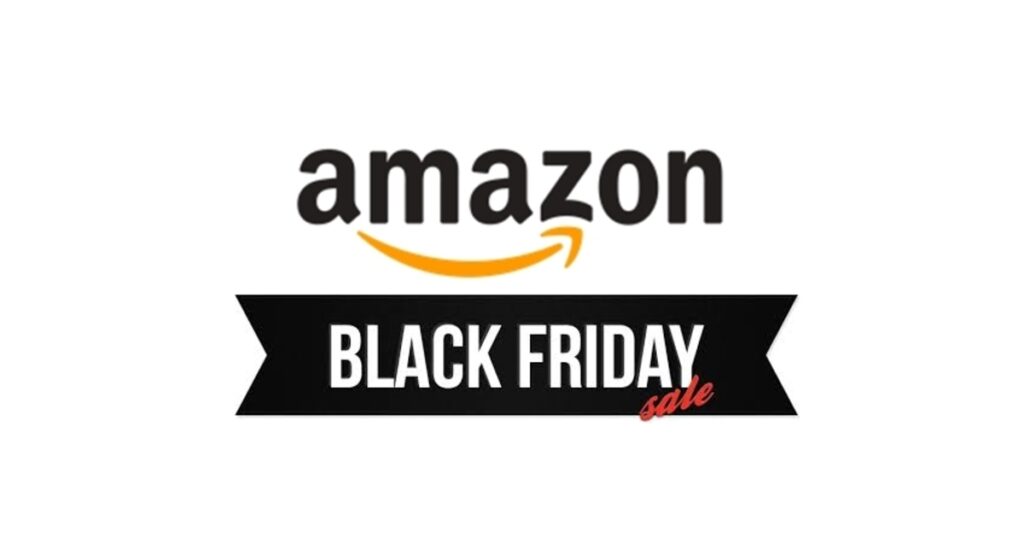
Seasonal Targeting & Messaging
Harness the power of Amazon DSP Ads for seasonal campaigns by targeting users actively searching for seasonal products or gifts.
Tailor your messaging and creatives to align with the seasonal theme, emphasizing promotions, discounts, or limited time offers.
Pro Tip: Plan ahead and create seasonal Amazon DSP Ads campaigns aligned with specific holidays or events. Customize your targeting options and ad creatives to resonate with the seasonal mindset of your target audience.
Conclusion
Congratulations! You’ve reached the end of the ultimate guide to Amazon DSP Ads. Armed with the knowledge and Pro Tips provided throughout this guide, you are well equipped to harness the full potential of Amazon DSP Ads and drive significant growth for your business.
Remember, success with Amazon DSP Ads requires continuous optimization, experimentation, and monitoring. Stay up to date with the latest trends and best practices in the advertising industry to ensure your campaigns remain effective and deliver exceptional results.
Now, go ahead and embark on your Amazon DSP Ads journey, reach your target audience precisely, and achieve your business goals on Amazon and beyond!
FAQs
DSP (Demand-Side Platform) ads on Amazon are a type of programmatic advertising that allows advertisers to reach their target audience using Amazon’s rich shopper data.
It provides advanced targeting options and ad formats to maximize the effectiveness of ad campaigns.
Amazon DSP ads are displayed on various placements, including Amazon-owned sites and apps such as Amazon.com, IMDb, and Kindle, as well as partner sites and apps. This wide reach ensures ads are shown to relevant audiences across the internet.
Amazon DSP and Amazon PPC (Pay-Per-Click) are different advertising platforms on Amazon. DSP focuses on programmatic display ads with advanced targeting options across the internet, while PPC is a keyword based advertising system that primarily displays sponsored products or sponsored brands within Amazon’s search results.

